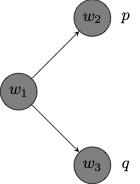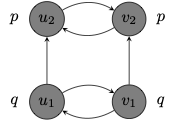9 Semantics
We will use possible worlds models to interpret the language.
Definition 9.1 (Possible Worlds Model) A possible worlds model
Given
We will use directed graphs to represent possible worlds models.
Example 9.1 Here is a depiction of a possible worlds model of the form

Each node corresponds to a possible world in the model.
The accessibility relation relates one world to another when there is an arrow that points from the first to the second.
The graph records the propositional variables that are true at each world according to
Notice that we do not have the means yet to ask whether a complex formula
Definition 9.2 (Truth at a World in a Model) We define what is for a formula
Let us return to the preceding example to explain how to compute the truth value of a formula at a world in a model.
Example 9.2 Consider the possible worlds model depicted by the graph:

Here is how to evaluate complex modal formulas at a world in the model:
This formula is true at worlds
This formula is true exactly at worlds
This formula is true exactly at worlds
This formula is true exactly at worlds
We now define what is for a formula to be true in a model:
Definition 9.3 (Truth in a Model) A formula
Example 9.3 Consider the possible worlds model depicted by the graph:

Here is how to evaluate complex modal formulas in the model:
This formula is true in the model because it is true at all possible worlds in the model.
This formula is true in the model because it is true at all possible worlds in the model.
Frames
There are two ingredients to a possible worlds models, there is the ordered pair of a set of worlds
Definition 9.4 (Frame) A frame
A model
For a formula
Definition 9.5 (Validity in a Frame) A formula
Example 9.4 Here are two formulas of
More generally,
Here are two formulas of
For a counterexample to the validity distributivity of

Notice that
Yet,
Notice that the model doubles as a counterexample to distributivity of
The formula
However,
We will often restrict attention to a class of frames and ask which formulas are valid in all and only those frames in the class.
Definition 9.6 (Validity in a Class of Frames) A formula
Proposition 9.1 Each formula listed below is valid in a frame if the accessibility relation satisfies the relevant condition.
| Formula | Condition on |
|
|---|---|---|
| reflexive on |
||
| symmetric on |
||
| transitive on |
||
| euclidean on |
Proof. We look at each case in turn:
- Let
- Let
- Let
- Let
Frame Definability
The success of the possible worlds semantics for propositional modal logic is connected to the fact that it sheds new light on modal principles via systematic correspondences between the validity of those principles and certain structural features of the modal accesssibility relation
Proposition 9.2 Each formula listed below is valid in a frame only if the accessibility relation satisfies the relevant condition.
| Formula | Condition on |
|
|---|---|---|
| reflexive on |
||
| symmetric on |
||
| transitive on |
||
| euclidean on |
Proof. We provide two styles of argument for each case. One targets the contrapositive of each claim, while the other consists of a direct proof of the conditional.
If
Suppose
If
Suppose
If
Suppose
If
Suppose
If
Suppose
If
Suppose
If
Suppose
If
Suppose
Let us make precise the the observation that each of the formulas discussed characterizes a class of frames.
Definition 9.7 (Modal Definability) A formula
Each of the formulas discussed above defines the class of frames in which the accessibility relation satisfies the relevant formal condition. That is,
The expressive power of propositional modal logic is measured by the ability to make distinctions. The language affords us the means to distinguish reflexive from non-reflexive frames in terms of the validity of the formula
First-order languages are able to make similar distinctions. Given a first-order language with a binary relational predicate
| Frames | Modal Definability | First-Order Definability |
|---|---|---|
| Reflexive | ||
| Symmetric | ||
| Transitivity | ||
| Euclidean |
One may now compare the expressive power of modal and first-order logic. Even if the class of reflexive, symmetric, and transitive frames are each modal and first-order definable, one may wonder whether every class of formulas defined by a first-order formula is modally definable and, vice versa, whether every modally definable frame is first-order definable.
The answer to both questions is ‘no’. Some formulas of
| Frames | Modal Definability | First-Order Definability |
|---|---|---|
| Irreflexive | No | |
| Universal | No | |
| Transitive Converse Well-Founded | No | |
| Identity | Yes | |
| Functional | Yes | |
| Serial | Yes |
Definition 9.8 A binary relation
Proposition 9.3 The class of transitive converse well-founded frames is not first-order definable.
This is a consequence of the Compactness Theorem for first-order logic: if a set of first-order formulas
Proof. For each natural number
Proposition 9.4
Proof. We want to prove that for all frames
Now, suppose
(
We will now look at two examples of first-order definable classes of frames that are not modally definable.
Bisimulations
We know that first-order formulas do not discriminate between isomorphic models. The role of isomorphism in first-order logic is played by bisimulation in modal propositional logic, since modal formulas do not discriminate between bisimilar models.
Definition 9.9 (Bisimulation) A bisimulation between two models
if
if
if
If
Example 9.5 There is a bisimulation
 |
 |
One way to think of the situation is that each of
The interest of bisimulations is that the language of propositional modal logic cannot make discriminations between bisimilar models.
Proposition 9.5 (Invariance Lemma) If there is a bisimulation
Proof. The proof is by induction over the complexity of formulas.
- Base Case. If
- Inductive Step for
- Inductive Step for
- Inductive Step for
Here is a more detailed justification of the step from
- Suppose
The converse direction is completely parallel but it makes use of clause 2 or the forth condition instead.
One immediate application of bisimulations is the ability to establish the undefinability of some classes of frames.
Proposition 9.6 Each model of the form
Proof. In broad outline, given a model
It is not difficult to verify that
Proposition 9.7 No formula of
Proof. No formula
We will now argue that no formula
First, a lemma:
Lemma 9.1 A formula
Proof. Given a formula
If
The contrapositive of this conditional is an immediate consequence of the observation that a universal relation
If
We set out to show the contrapositive. That is, if
That is, we let
A simple induction over the complexity of formulas reveals that for every formula
Corollary 9.1 No formula
Proof. Suppose
Much of the interest of validity in the class of universal frames is that they seem particularly suited for the evaluation of modal formulas when the modal operator is interpreted in terms of metaphysical necessity. Since the logic of universal frames coincides with that of frames in which the accessibility relation is a relation of equivalence, we appear to have reason to accept the validity of substitution instances of each of the formulas we considered above:
| Formula | Condition on |
|
|---|---|---|
| reflexive on |
||
| symmetric on |
||
| transitive on |
||
| euclidean on |
Yet, some have offered reason to resist this picture of metaphysical modality.
In (Chisholm 1967Chisholm, Roderick M. 1967. “Identity Through Possible Worlds: Some Questions.” Noûs, 1–8.) and (Chisholm 1973Chisholm, Roderick M. 1973. “Parts as Essential to Their Wholes.” The Review of Metaphysics 26 (4): 581–603.), Roderick Chisholm invites one to consider a ship built from one-hundred wooden planks with a tolerant essence in that the ship could have survived the replacement of one plank with a new one even if not the replacement of every plank with a new plank. That is, it is part of the essence of the ship that it can survive the replacement of a single plank whenever it exists.
One is now asked to consider a chain of possibilities, which starts with the original ship and where each possibility differs from the next just by the replacement of a single plank.
The paradox of tolerant essence arises when we combine what would otherwise seem reasonable thoughts:
- Each pair of successive possible worlds contain the same ship, since by hypothesis, the ship’s essence tolerates the replacement of one plank with a new one.
- By the transitivity of identity,
Chisholm is inclined to reject the hypothesis that the ship has a tolerant essence: if it is essential to it to be made of the original planks, then there is no reason to even think that successive worlds in the series contain the same ship. One may alternatively attempt to blame vagueness for the problem. Maybe there comes a point at which it is indeterminate whether the original ship has survived the replacement of a given number of planks.
But the real problem is not due to vagueness. In (Leslie 2011Leslie, Sarah-Jane. 2011. “Essence, Plenitude, and Paradox.” Philosophical Perspectives 25: 277–96.), Sarah Jane Leslie proposes to consider an axe made from three parts: a blade, a shaft, and a handle, and to assume that the essence of the. axe is tolerant to the change of one of those three parts. We are now asked to consider a chain of just four worlds each containing an axe made from three parts, where each axe differs only by one part from an adjacent axe, and the original axe is contained in the first world. That is, the original axe is
The paradox now arises when we note:
- Each pair of successive possible worlds contain the same axe, since by hypothesis, the axe’s essence tolerates one-part changes.
- By the transitivity of identity,
Vagueness appears to play no role in this formulation of the problem. Nathan Salmon has used the first formulation of the paradox in (Salmon 1989Salmon, Nathan. 1989. “The Logic of What Might Have Been.” The Philosophical Review 98 (1): 3–34.) to argue against the validity of
There is no paradox, though we would have one if we accepted every substitution instance of the formula: